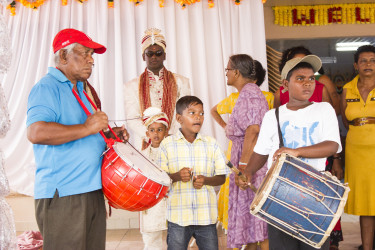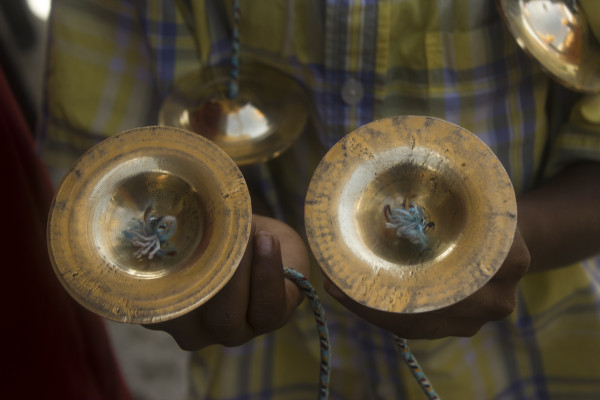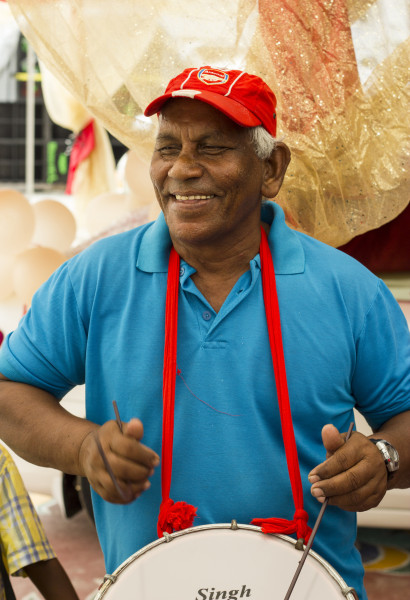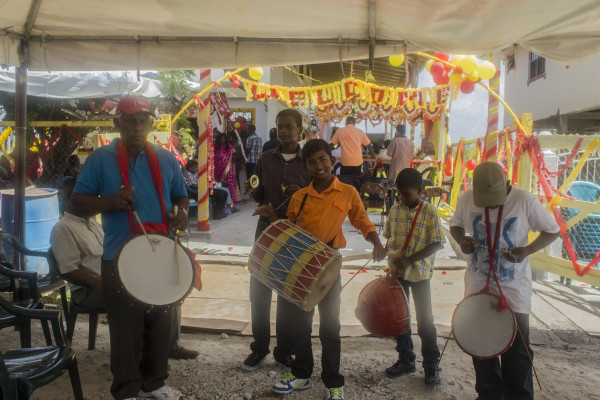“Jhal,” Uncle Raghu shouts, as he beats a huge drum down the East Coast Highway. We were at the back of a pick-up truck and he was shouting at one of his students, who was tasked with knocking the Jhal together. The Jhal is actually a miniature cymbal.

Uncle Raghu is one of the most renowned drummers in Guyana. He is 67 years old and has been playing the drums since he was a child. He has a semi-circle of white hair, wrinkles of experience and hands that are strong like bamboo.
Uncle Raghu can make nineteen drums, including African drums. He is a former teacher of Mathematics, but drumming is in his veins. The retired teacher now teaches children to play the drums, and plays at Indian cultural events, mostly weddings. I first met Uncle Raghu at the National Cultural Centre; he was at a rehearsal for a rendition of the epic religious Indian play, Ramlila.
I introduced myself to him. He smiled and said, “Ohh, you’s the boy that wanna do an article for Stabroek News…well listen man, a got a wedding tomorrow, if you wanna see what the drumming is really like, you got to come to de wedding to really understand de thing.” And that was it, I was invited to my first Hindu wedding and my heart pounded with excitement.
The next morning I found myself in a bus to Atlantic Gardens. When I arrived, I called Uncle Raghu and asked him for directions. “Oh ya here, well listen na man, ya gon hear de drums, jus listen and follow it,” Uncle Raghu said.
I did not hear any drums. But as I walked closer, the drums roared and my feet began to tap. Then, the drumming stopped. My ears could not follow silence. I needed to hear the drums. I asked a resident for directions and he showed me to the corner, where the Indian wedding was taking place. When I arrived, uncle Raghu was sitting in a blue t-shirt with a red cap concealing his white hair. He had two students with him, Dinko and Pradesh.
“Ya reach,” he said, “well here, this is the wedding, you can go and take photos if you like.” I was apprehensive about photographing the wedding, especially since no one had hired me. Uncle Raghu was insistent, however, and a woman who sat beside me, asked why I was apprehensive.
“Go ahead, you are welcome to take photographs,” the woman said. It was a long ritual, which required patience at the groom’s end, while his feet were painted by his grandmother and his mother sat behind him crying sadly, while the grandmother gave instructions.
I began to think, how wonderful it was that Hindus kept their culture alive and well in Guyana. And how sad it is that African culture had been stripped from us, and now most of us are ashamed of it, see it as inferior and only dress up once a year to preserve it.
After the ceremonial ritual, Uncle Raghu was called to play. “Come Uncle Raghu come play a song for we nah man,” One woman said.
Uncle Raghu came with Dinko and Pradesh and began to beat the drum. The drum did not seem to be an object that was separated from his body. It was an extension of him. It was a part of his body.
The drums were beaten with rhythm and fusion and the wedding revellers danced as Uncle Raghu and his students increased the pace. Their feet moved and even the mother, who was sad during the ritual, began to shake. An older East Indian woman was at the centre of the dancing. She wore a yellow dress and had thin limbs that moved in time with the music. Her balance was impeccable; she would balance on one foot and made circular motions with her hands. The drumming brought laughter and vibrancy to the once quiet, revered surroundings. The old woman even danced for the groom; he smiled. I could not tell if this was a fake smile or someone who was having genuine fun. I went with the latter. After the dancing ceased, it was time for the groom to visit the bride at her home in Lusignan. The drums were pounded when the groom made his way to the car.
Uncle Raghu directed me to the pick-up and we were off. Whenever we passed houses, curtains were pulled, doors were opened and eyes peeked out to see what all the commotion was. They saw an old man, who displayed childlike glee. His head went up and down, and when the drums got louder his shoulders joined in and the smile on his face could not be rubbed out. Dinko and Pradesh sat next to me with me, Pradesh was playing the Jhal.
When we hit the highway, many faces lit up at the sound of the drums. Some persons on the road could not help but move their feet and wave their hands. The drumming fever had overtaken most of the East Coast Highway. The ones who danced were mostly middle aged or old.
The drumming had a constant rhythm and when it shifted to something else, it was hardly noticeable. You had to listen. The only complaint I had was the sound which boomed in my eardrums. It was that unpleasant stinging that you get whenever you travel in a noisy minibus. I had to shift my head to a comfortable position so as not to feel it and truly enjoy the music. I wanted to get up and dance foolishly, but inhibitions overcame me that day.
“Come play lil now man, meh han’ tired,” Uncle Raghu said, as he handed over the stick to Pradesh, who eagerly collected it and began to play. ‘Rhythm,’ Uncle Raghu shouted. Pradesh’s beat changed and Uncle Raghu nodded his head in approval. Dinko had the Jhal. And for a brief period, the drums went along with the words, ‘rhythm and jhal.’
We soon arrived at the bride’s home and once again Uncle Raghu led the way. There were two other young drummers at the bride’s home, Navin and Alvin. Uncle Raghu’s son was also there.
Uncle Raghu and his students played their heart out, but it was a tough sell. The crowd was dead.
A huge stereo set, drowned the drumming out and Uncle Raghu had to take a seat.
Later in the day, a wedding attendee pulled him aside and asked him to play the drums at a yard across the street from the wedding. Uncle Raghu quickly called the students, grabbed his biggest drum and began to play for the man. The man danced with glee and pretty soon other men joined in.
Uncle Raghu beat the drum mightily with his drumming stick. He jumped into the air and pounded the drum. Feet shuffled from side, hands went up in the air, men laughed, men drank and men thanked Uncle Rhagu for playing the drums. He then began to entertain them with rhymes.
“Joke, Joke, mek this plait shirt boy choke,” Uncle Raghu said, and the small crowd roared with laughter. “This boy hay, he does go by he galfren, ling ling, but when abe check um out, he na fit one thing,” the crowd laughed again.
And Uncle Raghu made one last joke, “long ago when Guyanese gal a gone Trinidad, dem a fly wid airplane and when the come back, them a cry fa belly pain.”
The jokes hit the men’s sweet spots and Uncle Raghu was called to play at the centre of the reception. The stereo stopped playing and this time, both men and women danced. Circular motions of the hand, hips moved from side to side and buttocks went up and down. The people laughed and the space got crowded. Uncle Raghu ended the day on a high note. “I’ve made my name in Lusignan, I have never played there before,” Uncle Raghu said smiling, while we made our way back to town.
Uncle Raghu began to tell me how wonderful drumming has been for him and the fruits that he has reaped because of his commitment to the culture. I had written at least a dozen questions for him and was hoping to interview him. He could not do the interview in the near future because of his busy schedule. This saddened me; I hoped to understand drumming more. Uncle Raghu inspired me, he is a cultural gem that is hidden away on the East Coast; he is a special person and I have not given up on my interview. Some day he’ll have time and some day I’ll cover his experiences from childhood to now.








